Are you trying to decide which HVAC system is best for your purpose?
This handy guide will help you decide between a packaged or split AC unit.
The AC unit you choose lasts a decade or more, so compare the characteristics and eliminate options to make the right choice.
Split vs Packaged AC Unit

Split AC Unit

Packaged AC Unit
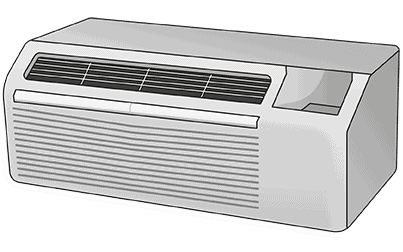
Pros
Split AC Unit
Low noise
High efficiency
Lower maintenance
Packaged AC Unit
Less space
Easy maintenance
Low installation cost
Cons
Split AC Unit
Uses indoor space
High installation cost
Split location of components
Packaged AC Unit
Lower lifespan
Higher running costs
Vulnerable to elements
Best For
Split AC Unit
Best for smaller homes and commercial properties with more limited outdoor space
Packaged AC Unit
Best for larger homes and commercial properties
What is a Split AC Unit?
Air Conditioners work by transferring heat energy away from the room that needs cooling. Refrigerants, sometimes called gas, transfer the heat. A compressor compresses the refrigerant and passes the pressurized gas through the condenser coils.
The coils cool it enough to change to a liquid state. The refrigerant, still under pressure, now passes through the air treatment section of the AC unit, which houses a fan and evaporator coils. The expansion valve before the evaporator coils causes a pressure drop in the refrigerant. The pressure drop causes the refrigerant to start boiling. As the refrigerant boils, it absorbs energy from the surrounding air. This energy is carried to the condenser coils and dissipates to the outside air.

What Components Come With a Split AC Unit?
In a split AC unit, the compressor and condenser coils are split from the air treatment unit and installed outside. Only the air treatment part of the product is inside the building. Because the compressor and cooling fan are both noisy and large, the split AC unit is quieter and more compact than other types.
This type of unit is also known as a ductless system and has high efficiency because air is cooled right in the room without traveling through ducting.
What is a Packaged AC Unit?
An AC unit that contains all the components in a single casing is known as a packaged unit. Ducting carries the air to the areas that require cooling or heating, in the same way as central AC. Packaged units can either be mounted on the roof or a slab, depending on their size.
The packaged type of AC occupies the part of the market between split and central AC units. Applications up to five tons (60 000 BTU) typically use a split system, and applications above 20 tons (240 000 BTU) use central AC units. Packaged AC units are available in three, five, seven, ten, and 15-ton capacities.
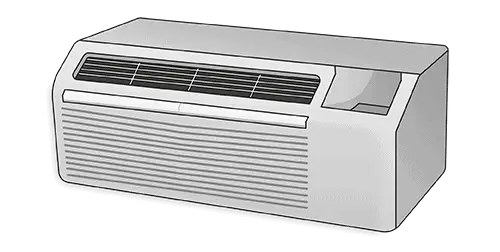
What Components Come With a Packaged AC Unit?
The packaged AC unit contains the compressor, condenser, condenser fan, the evaporator coils with an expansion valve, and a strong blower with a flange for ducting. The same casing also houses the heating elements.
Because a single housing contains all the components, the unit is assembled and charged in the factory, then delivered to the site as an operable system, substantially reducing installation costs. Only the ducting needs installation on-site.
Relevant Characteristics Between Split and Packaged AC Units
Split vs. Packaged AC Unit
Compare by tapping or clicking below!

Cost
Split AC Unit
$4,496-$12,398
Packaged AC Unit
$3,795-$7,750
Efficiency (SEER)
Split AC Unit
15-26
Packaged AC Unit
15-21
Cooling Capacity
Split AC Unit
Up to 60,000 BTU
Packaged AC Unit
36,000 BTU- 180,000BTU
Space Requirement
Split AC Unit
3.0 sq.ft-27 sq.ft
Packaged AC Unit
24.5 sq.ft- 91 sq.ft
Noise Level
Split AC Unit
35-46dB
Packaged AC Unit
35-46dB
Maintenance Requirement
Split AC Unit
$100-$150 per year
Packaged AC Unit
$150-$500 per year
Similarities and Differences
There are many similarities between the two HVAC systems, but there are significant differences too. These differences are ultimately the deciding factor when choosing which type of system to install, so we will discuss them first, helping you decide which HVAC is best for your application.
Split and Packaged AC Unit Differences
Installation
The split unit requires some on-site assembly, whereas a packaged unit is delivered in a ready-for-use condition. The entire packaged unit is assembled and tested in the factory lowering the installation costs.
Only the ducting of a packaged unit is in the building itself, whereas the refrigerant piping, wiring, and any ducting need to be laid for the split system.

Space
The split system needs less outdoor space and more indoor space than the packaged system. The split system either uses individual air treatment units(ATUs) for each room or a single, larger ATU in the basement or attic, with ducting running to the individual rooms. The packaged system has everything in one place, with only ducting running inside the building.
Maintenance
The packaged unit has all the components in a single cabinet, making maintenance and accessibility easy. The split unit has some components outdoors, and some inside the building. The indoor components may not be easily accessible, but they’re more protected from the weather, meaning less wear and tear and consequently, less maintenance.
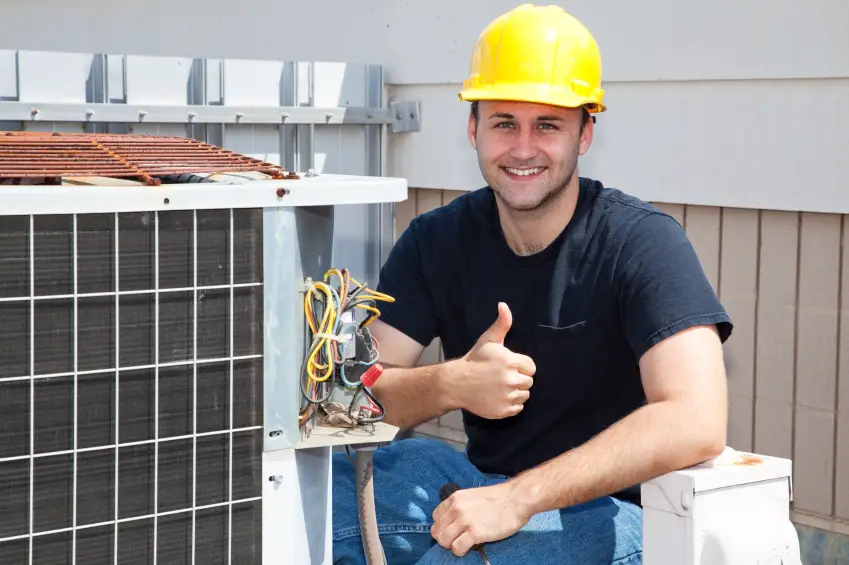
Efficiency
The split unit will always have a higher efficiency rating than packaged units, especially if you opt for separate ATUs for each room. The reason for the higher efficiency is that the treated air is running through less ducting, or even no ducting.
Air Quality
The indoor ATUs of the split system delivers a better air quality than the packaged versions, with an outdoor ATU.
Power (BTU)
The packaged HVAC offers a more powerful system than the split HVAC. Split units are normally used for applications up to 60 000 BTU, whereas the packaged system offers a range between 36 000 and 180 000 BTU. For a larger installation, the packaged unit is best.
Split and Packaged AC Unit Similarities
Quiet Operation
Both these types of HVAC are known for their quiet operation. The noisy compressor and condenser fans are outside and away from the area to be treated.
Indoor Space Savings
The packaged unit has all of its components outside, and although the split unit has the ATU portion inside the building, this takes up a lot less space. Either of these options is a good fit for a smaller building without a lot of indoor space, compared to a central HVAC system.
For an apartment, the outside units can even be fitted onto a balcony, if you don’t mind sacrificing that space. The downside of this is that you sacrifice outdoor space to save indoor space. Sometimes the cabinets look unsightly, but you can disguise them.
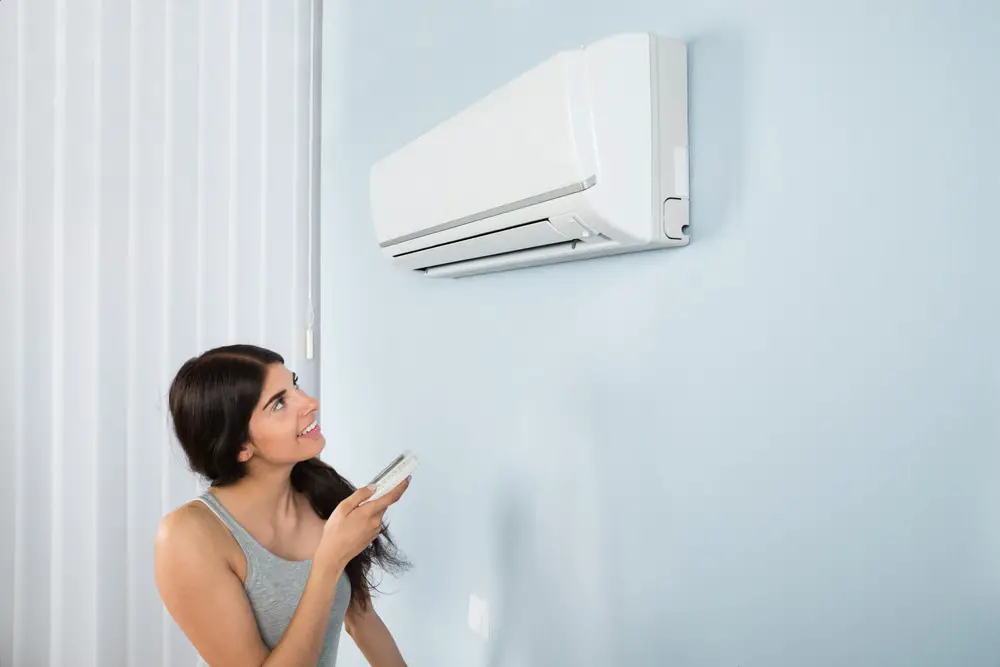
Versatility
Both units can have the outside portion placed anywhere near the building, or in some cases on the roof, although it’s always best to install them as close as possible to the entry point for the piping or ducting.
Controls
The thermostat settings of both types of HVAC are accessed from inside the building, either from a panel or with a remote. This gives the user better control over temperature and airflow. In the case of a ductless split system with individual ATUs, the user can have different settings for different rooms.
When and Why Would I Use a Split AC Unit?
A split AC unit is popular among homeowners because of its many advantages, and in the right circumstances, it is the right system to choose from. But always consider the feasibility of installing this type of system if you already have a different HVAC system installed. The chief advantages of these systems are listed below:

Economy
Split AC units have a higher Seasonal Energy Efficiency Rating (SEER) rating. The higher SEER rating means lower energy bills in the long term. A more efficient HVAC unit also increases your home’s resale value.
Durability
The more delicate electrical components are installed indoors, protected from the weather. If there is a chance of outdoor components being damaged, or invaded by wildlife such as birds, it makes sense to have as much of the installation indoors as possible. The split system is also less prone to rust and other environmental factors, so it lasts longer and requires less maintenance on major components.
Indoor Location of ATU
An indoor ATU is advantageous as it requires less ducting, or in the case of multi-split ductless units, no ducting. Having the ATU indoors also results in better air quality within the home, and less maintenance on the air treatment components such as the evaporator coil, fine filters, and fans.
Disadvantages of Split AC Unit
There are also some disadvantages to installing a split AC unit as detailed below:
Complex Installation
The complexity of the initial installation leads to extra costs. Instead of having a fully-functional HVAC unit delivered to your home, there are at least two components that need to be installed and connected before the unit is operational.
Refrigerant lines need to be connected, and penetrations need to be installed for the piping. The entire system then needs to be vacuumed to remove moisture and impurities before it can be charged and set to work.

Maintenance
The unit is split into parts, so the maintainer has to access different parts of the building to do a complete maintenance check-up. If the ATU section of the unit is installed in a roof space or crawl space it can sometimes be difficult to access.
It Still Takes up Some Space in the Home
There are still components that need to be installed inside the building. Although the inside space used is less than a central AC system would have used, you still need to sacrifice some space. If the system is to be used for a small building or home a packaged unit may be a better option. In the case of a multi-split ductless system, the ATUs are mounted on the wall and may detract from the home’s interior design.
When and Why Would I Use a Packaged AC Unit?
Some factors may make the packaged AC unit a more attractive option, and these should also be taken into consideration when choosing a new or replacement HVAC.
Budget
The packaged system comes fully assembled and is easy to install. The simplicity of installation reduces both labor and material costs. Only the unit itself needs to be fixed in place and the air ducting installed or replaced, making this one of the cheapest types of HVAC to install.
Space Savings
The packaged unit gives the installer many options for the installation of the cabinet containing the HVAC system. This system can be installed on a slab, a balcony, or even a rooftop, provided that the roof pitch isn’t too steep. If the home, building, or apartment has limited indoor or outdoor space, the versatility of placement makes this type of unit an attractive option.

Ease of Maintenance
With all the components housed in a single casing, the maintenance of this unit is simplified. The maintainer doesn’t even need access to the building, only the cabinet of the HVAC system, making it ideal for business premises such as a restaurant.
Disadvantages of a Packaged AC Unit
There are also a few drawbacks to installing a packaged HVAC that need to be balanced against the advantages.
Efficiency
These units have a lower SEER rating than the split-type HVAC systems, which means that you are trading installation cost for running cost. A home with a lower-rated HVAC isn’t as appealing to potential buyers as one with a star-rated HVAC.
Vulnerability
All the components of this unit are installed in a single outdoor casing, making the system more vulnerable to the environment. Rust, nesting birds, and sometimes rodents cause problems with these installations.
Shorter Lifespan
The shorter lifespan of these units is related to the outdoor location. Because all the components, including the ATU, are located outdoors and more susceptible to the elements, the intervals between replacement and maintenance are shorter than a split system.
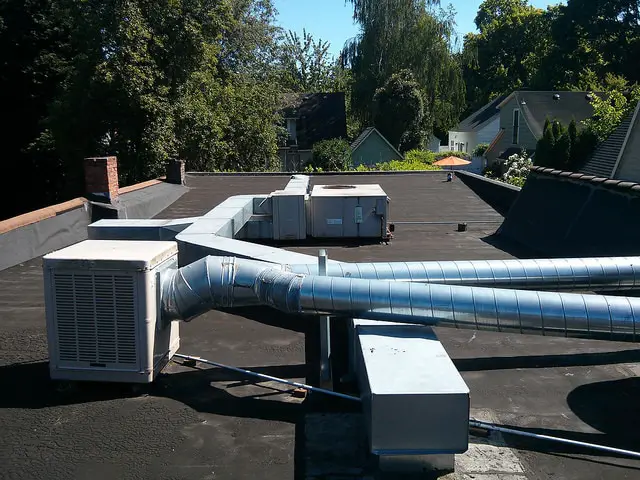
Roof Location
Units located on the roof are both an advantage and a disadvantage. While installation and maintenance are easy on a flat roof, sloped roofs pose a problem, as a flat platform first has to be built to mount the unit.
Roof access for maintenance also poses a problem sometimes, so these factors need to be taken into account when determining location. A roof-mounted HVAC can also detract from the building’s appearance.
What About Heat Pump Systems?
A heat pump is an AC that can reverse the direction of heat transfer. There is a reversing valve on the compressor so that the condenser and evaporator coils can change their function.
Whereas a conventional AC unit such as a packaged or split system needs to be used in conjunction with electrical heating coils or a furnace, in milder climates, the heat pump eliminates the need for these.
When in the heating cycle, heat pumps become inefficient at temperatures below freezing. Cold climate heat pump installations would still need to have another heating source.
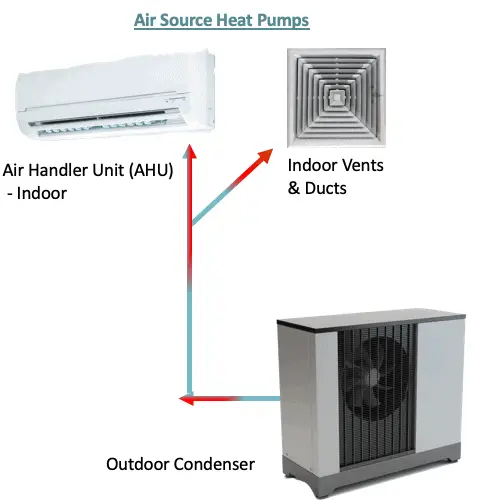
The installation cost of a heat pump system is about 5% higher than conventional systems, and because the compressor runs throughout the year, the maintenance intervals are more frequent and the maintenance costs higher.
The lifespan of a heat pump system is also shorter than conventional systems because it’s running throughout the year. Still, a well-maintained heat pump can last ten to twenty years.
Under ideal conditions, the efficiency of heat pumps and air conditioners is even. The real savings come when comparing the heat pump to electrical heating coils or a furnace.
In heating mode, the heat pump achieves an efficiency of between 175% and 300%, although at temperatures below freezing a backup or hybrid system is recommended. The heat pump is a great solution for milder climates but loses most of its benefits in extreme temperatures.
Extremely hot climates don’t require the heating function and the heating efficiency is low in extreme cold, so you still need an alternative source of heating.
Bottom Line
When it comes to choosing the correct HVAC there are no absolute answers. Factors such as available installation space or cost can eliminate some of the options early.
If long-term savings are your goal, then a split system is best, but if installation cost is a bigger factor then the packaged system is better. If you have limited space for an outdoor installation, then a roof-mounted package system is worth looking into, or perhaps there is space for a split unit, but not the entire packaged HVAC.
Choosing the right system is a process of elimination. Your unique circumstances will help you choose the best system for you.
People Also Ask
There are always extra questions to be asked, or perhaps you have only one query that you want to be answered quickly. We have compiled answers to the most commonly asked questions below.
Every installation is different, with different factors to take into consideration. Less is usually more though, so unless there is a compelling reason to install two ACs, one is better. Installing two ACs doubles the installation, running, and maintenance costs.
Yes. Be careful that the indoor unit is compatible with the outdoor unit though. You can match the two units through model numbers to ensure that they are compatible. If your split AC is an older model, it may be better to replace the entire system, or you may not be able to find a compatible indoor unit.
Yes. So long as the outdoor unit is strong enough. You can either run ducting from a single ATU to both rooms, or you can run refrigerant lines to each room and install separate ATUs (ductless multi-split system).
It’s impossible to predict how long a system will last, as there are different factors to consider. A well-maintained, properly installed system lasts longer than a poorly-maintained or improperly installed system. A split system lasts an average of twenty years and a packaged AC lasts an average of ten to fifteen years.
Both the split and the packaged AC are very quiet, but the packaged AC has fewer indoor components, making it even quieter. If either of these systems is making a noticeable noise, there is a fault that needs fixing.
A packaged unit is easier to install. All the components are already connected in the factory and the system is charged with refrigerant and tested. All that needs to be done is to fix the unit in place and run the air ducting. On a split unit final assembly, charging and testing are done onsite.
